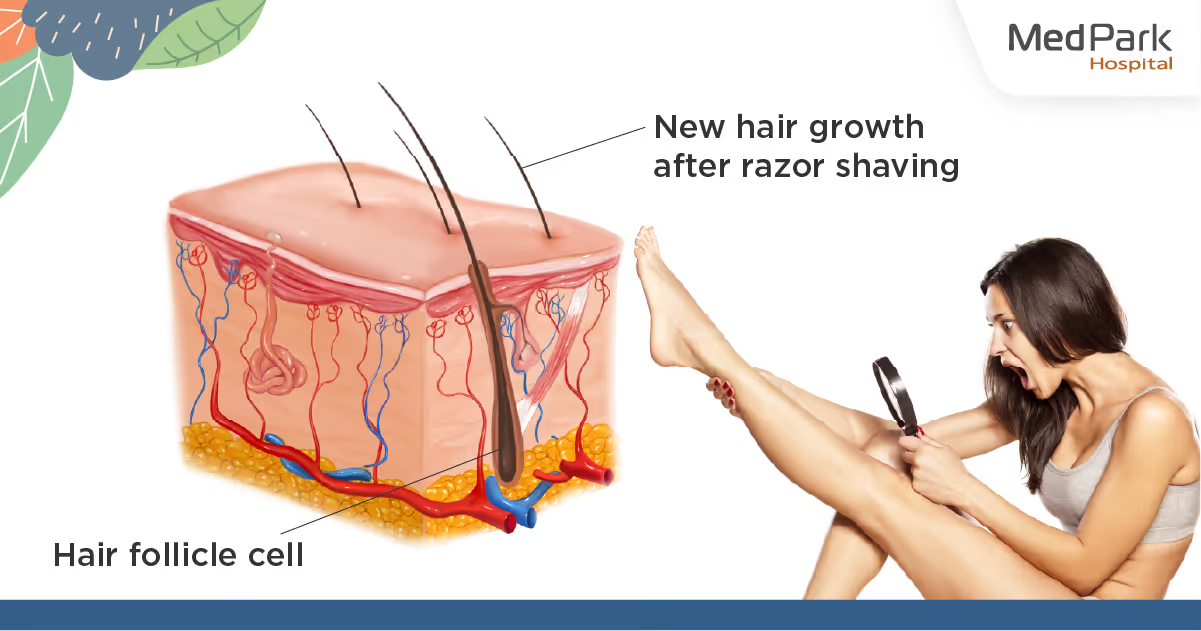Choose the content to read
- Which parts of the body can laser hair removal treat?
- Who can have laser hair removal?
- What is a laser hair removal procedure?
- How many sessions of laser hair removal?
- What are the side effects of laser hair removal?
- What are the benefits of laser hair removal?
- Laser Hair Removal at MedPark Hospital
Laser Hair Removal
Laser hair removal is a non-invasive medical procedure that permanently removes unwanted hair using a concentrated beam of light. An Nd:YAG laser emits light into the hair follicles, enabling the melanin pigment to absorb heat until the hair follicle root cells are destroyed and fall out and inhibiting new hair growth. Nd: YAG laser is very safe and effective; the laser can remove hair follicles from nearly any part of the body as desired, including the face, legs, and armpit. Laser hair removal is a hair-removal procedure that often yields optimal results, has minimal side effects, and is regarded as one of the best permanent hair removal options.

Why laser hair removal?
Shaving is a quick and easy way to get rid of unwanted hair that can be done anytime, whenever you want. Nevertheless, new hair will soon regrow out of the follicles within a short period of time since the method only removes hair above the epidermis, not deeply within the hair follicles. Similar to waxing, this method can depilate hair down to the hair follicles, but shortly the hair will regrow upward outside the epidermis due to the hair follicle root cells still being alive.
Laser hair removal is a hair-removing method that greatly depilates hair down to the hair root cells using an Nd:YAG laser, which emits safe and innocuous 1064-nanometer light energy waves in the infrared spectrum into the hair follicles, enabling melanin pigment to absorb the thermal energy and converting it into heat that effectively destroys the hair root cells. Laser hair removal offers long-lasting results; the hair will progressively get thinner until it completely falls out over repeated sessions according to the treatment plan, revealing silky smooth, hairless skin, enticing caress touches.
Which parts of the body can laser hair removal treat?
- Facial hair
- Mustache, beard
- Armpit hair
- Back hair
- Calf hair, leg hair, shin hair
- Bikini hair, pubic hair in women and men, buttocks hair (Bikini wax, Brazilian wax)
Except around the eyes, eyelids, eyebrows, tattooed skin, scarred skin, or sensitive skin.

Who can have laser hair removal?
- Individuals with hairy skin, thick hair, or ingrown hair (Keratosis pilaris)
- Individuals with atopic dermatitis, skin irritation, or dislike of removing hair by shaving or waxing
- Individuals who want to lessen bacteria and the stinky odor in hairy areas
- Individuals with light skin but dark hair, or dark skin but light hair
- Women with dark hair or coarse hair in areas where men usually have hair (Hirsutism)
- Women or men with thick, hairy skin throughout the body (Hypertrichosis)
- Individuals who want to permanently remove their hair to save time and money in the long run, or individuals who do not want to have their hair removed repeatedly, over and over again.
Who shouldn’t have laser hair removal?
- Pregnant women
- Those taking acne medication (stop taking medications for at least 6 months)
- Skins with keloids, tattoos, or open wounds
- Those with skin infections such as ringworm, psoriasis, or herpes simplex
- Those taking medications for underlying conditions such as lupus, diabetes, or skin cancer
What is the preparation for laser hair removal?
- 1 month before laser hair removal, avoid waxing and apply sunscreen SPF30++ to protect your skin.
- 2 weeks before laser hair removal, avoid sun exposure, tanning, and antibiotics.
- 1-3 days before laser hair removal, trim the targeted skin where laser hair removal will be performed. Do not trim or shave on the same day as the laser hair removal.

What is a laser hair removal procedure?
- The dermatologist emits a high-intensity laser to destroy hair follicles, deeply beneath the epidermis, to direct thermal energy.
- The thermal energy is absorbed by the hair pigment-melanin and converted into heat.
- The heat effectively destroys the hair root cells, impeding its ability to regrow the hairs and fall off over repeated sessions.
What is laser hair removal aftercare?
- 2-6 weeks during the procedure, avoid exposure to sunlight and apply SPF30++ sunscreen to protect the skin.
- Apply topical medication as prescribed by the doctor to relieve possible side effects.
- 1 day after laser hair removal, avoid shaving, waxing, or plucking hair with tweezers.
- 1 day after laser hair removal, avoid sweating, exercise, swimming, saunas, hot showers, and wearing tight clothing.
- The doctor will schedule 2-6 follow-up laser hair removal sessions based on the condition of each patient and the treatment areas. For example, in 4–8 weeks for areas with fast hair growth, such as the lips, and in 12–16 weeks for areas with slower hair growth, such as the back.
How many sessions of laser hair removal?
Typically, the doctor will schedule laser hair removal appointments for 6 sessions spaced 4-5 weeks apart, depending on the targeted areas, hair type, hormones, genetics, hair color, and treatment plan of each individual, as planned by the doctor. However, in some people with certain medical conditions or high testosterone, the doctor may decide to repeat laser hair removal procedures for more than 6 sessions, depending on the doctor's discretion.

What are the laser hair removal results?
Results after laser hair removal vary depending on the individual, the targeted areas, and the completion of a scheduled treatment session as prescribed by the doctor. Typically, the hair will not fall out all at once. Instead, the hair will become thinner and less dense after each treatment session, and the patient can see progressive improvement over time. After 6-8 weeks, they will notice more and more hair falling out permanently.
What are the side effects of laser hair removal?
Common side effects of laser hair removal include itching, redness, and swelling during the first 2-3 hours after treatment. To relieve the symptoms, the doctor will prescribe topical medication and recommend applying a cold compress. For patients experiencing skin allergies right after laser hair removal, the doctor may consider prescribing steroid medication to alleviate the symptoms. Typically, laser hair removal is a very safe hair removal procedure with fewer side effects.
What are the benefits of laser hair removal?
- Quick outcomes from the start: less hair grows, the new hair growth is lighter in color, and smaller
- Highly effective, ND:YAG lasers can deeply penetrate the hair follicles and destroy hair follicle cells
- Ability to remove hair from wiry, curly, coarse, thick, and ingrown hairs, which helps reduce folliculitis
- Yield permanent results compared to blade shaving, waxing, or plucking with tweezers
- Does not hurt like waxing and tweezing; feels like a slight flicking of a rubber band against the skin
- Very safe, quick, and convenient; ultimately great options to save time and money in the long run

Laser Hair Removal at MedPark Hospital
MedPark Hospital, Bangkok, Thailand, provides permanent laser hair removal with the leading-edge Nd: YAG laser, featuring a cooling system that provides comfort throughout the procedure. The laser can deeply penetrate the hair follicles and can remove hair effectively under the supervision of a specialist team from the Dermatology and Aesthetic Clinic and Hair Center with expertise in all types of hair removal on all parts of the body, which requires gentle and sophisticated care, combined with the use of FDA-approved medical equipment, ensuring a safe, convenient, and fast treatment procedure to deliver permanent results of hair removal treatments, while providing consistent postoperative care to ensure the patients receive good treatment outcomes, free of major complications, and have silky smooth, sleeky complexions, ready to reveal hairless skin with confidence.








